When we arrived at Jaguar Camp in Porto Jofre, a tiny outpost in Brazil’s northern Pantanal, we were unsure what the days ahead might hold. Our mission was simple. We wanted to see jaguars in the wild. Jaguars, however, are notoriously elusive and hard to spot, which means the prospect of seeing one – never mind a quality sighting – is far from guaranteed.
But the Pantanal’s unique. The world’s largest wetland, the Pantanal’s network of waterways, savannas, and gallery forests are home to South America’s highest concentration of wildlife. According to the World Wildlife Fund, 3,500 plants, 656 bird, 325 fish, 159 mammal, 53 amphibian, and 98 reptile species can be found. It’s a biodiversity hotspot ripe with superlatives. And high among them is the Pantanal’s notable population of jaguars and reputation for reliable dry season sightings.
Disclosure: This page may contain affiliate links. Clicking through for additional information or to make a purchase may result in a small commission at no extra cost to you. We hope you find this information useful and welcome any questions you may have.
A Guide to Seeing Jaguars in the Wild
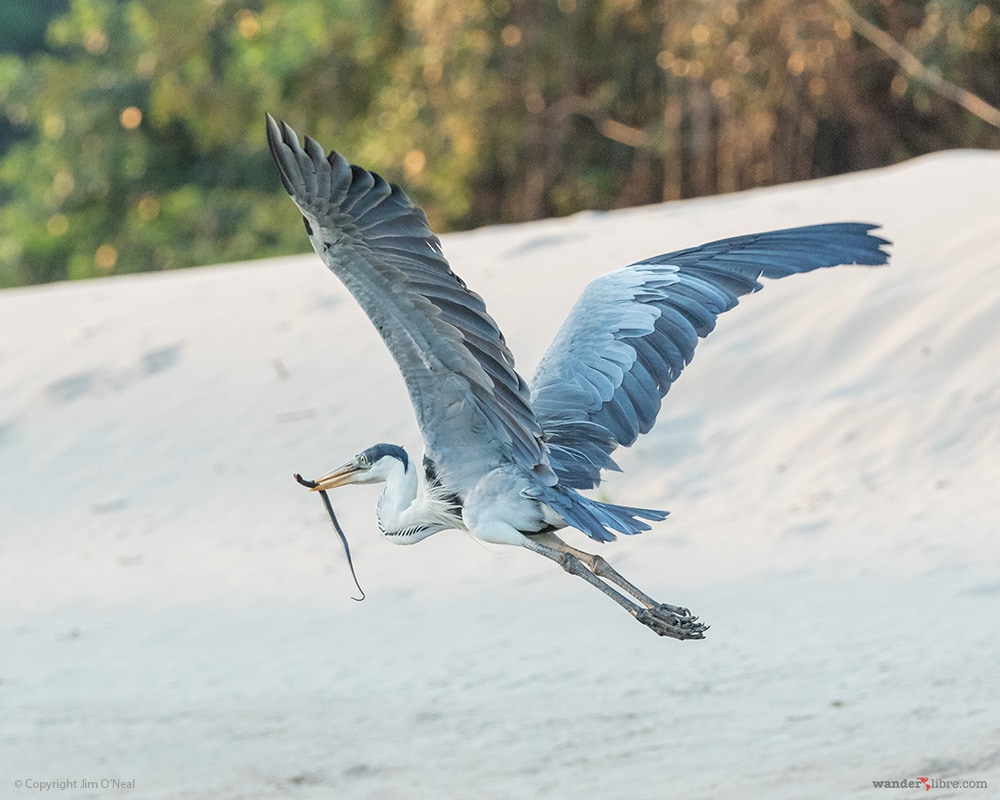
When we arrived at Pantanal Jaguar Camp, we were meet by Ailton Lara, the camp’s owner and chief guide. Ailton exudes enthusiasm, particularly when it comes to the camp’s namesake. He’s the type of guy who spends long days guiding clients in search of jaguars and then goes on vacation to places like Bolivia where he searches for still more jaguars. Ailton’s passion is infectious, and his knowledge is confidence inspiring. “Don’t worry,” he said. "We’ve had good sightings lately. Just be ready tomorrow at 7:00 a.m., and we’ll see what we can find.”
The next morning we woke early in anticipation of the day ahead. Outside, capuchin monkeys moved noisily through the trees above our tent and the forest was alive with bird chatter. At 7:00 a.m. we met Ailton and, after a quick briefing, followed him a couple of hundred yards to a small dock on the Rio Sao Lourenco. At the dock we boarded an 8-passenger steel hulled speedboat, and without delay, we were off.
We were moving quickly. Racing across the Rio Sao Lourenco’s glassy surface was instantly relaxing. The mix of cool breeze, soft sunlight, and picturesque landscape lulled us into a spa-like state of calm. It was a calm that didn’t last long.
Ailton shouted over the boat’s motor. “Jaguar! Swimming just to our right.” As the boat slowed, our hearts began to race. Caught a little off guard by the quick sighting, we struggled to get our bearings. “Over there!” Sheri called out. A short distance away a jaguar was swimming across the river – its head just above the surface. The jaguar was moving with purpose and soon reached the other side, leaping up an impressively high sandbank and working his way along the river's edge. “He’s hunting caiman,” Ailton said. We followed, observing the hunt from the river.
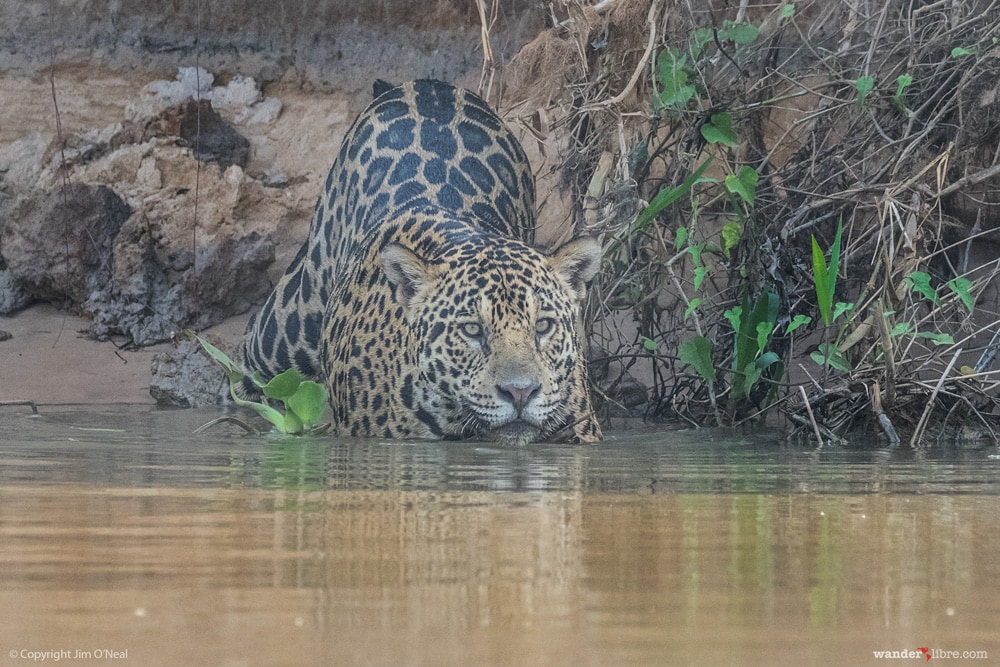
Over the next half hour, the jaguar moved along an elevated riverbank with eyes fixed on the water below. Occasionally, he’d slip into the water and swim along the river’s edge, scouring stands of hyacinth before climbing back out to resume his search from above. Ailton continued his narration “If the jaguar finds a caiman, he’ll ambush. Jumping onto the caiman’s back, the jaguar will try to kill the caiman with a skull-crushing bite to the back of the head. It’ll happen fast so be ready.”
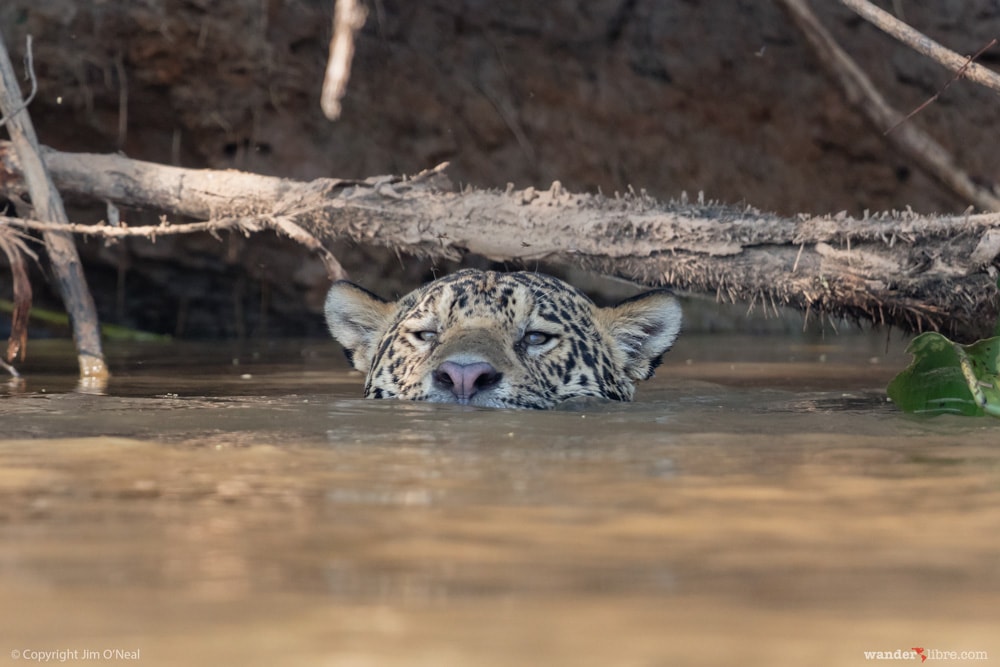 What we were yet to realize was that we’d just witnessed the opening act of an outdoor drama that would continue unabated. In just two days of searching, we spotted 12 jaguars, including seven during that first day alone. Our Brazil safari was off to a great start. Virtually all of our sightings were eventful. Unlike lions in Africa, which often spend days lazing in the shade, many of the jaguars we spotted were active right through the midday heat. Taking frequent dips in the river to cool off, we observed jaguars swimming, hunting, and mating. We heard a jaguar roar. Came eye-to-eye with a jaguar lazing on a branch overhanging the river, and watched a big male race down a sandy beach to make a caiman kill. It was an exhilarating wildlife view to be sure. We were getting sightings that far exceeded our expectations.
What we were yet to realize was that we’d just witnessed the opening act of an outdoor drama that would continue unabated. In just two days of searching, we spotted 12 jaguars, including seven during that first day alone. Our Brazil safari was off to a great start. Virtually all of our sightings were eventful. Unlike lions in Africa, which often spend days lazing in the shade, many of the jaguars we spotted were active right through the midday heat. Taking frequent dips in the river to cool off, we observed jaguars swimming, hunting, and mating. We heard a jaguar roar. Came eye-to-eye with a jaguar lazing on a branch overhanging the river, and watched a big male race down a sandy beach to make a caiman kill. It was an exhilarating wildlife view to be sure. We were getting sightings that far exceeded our expectations.
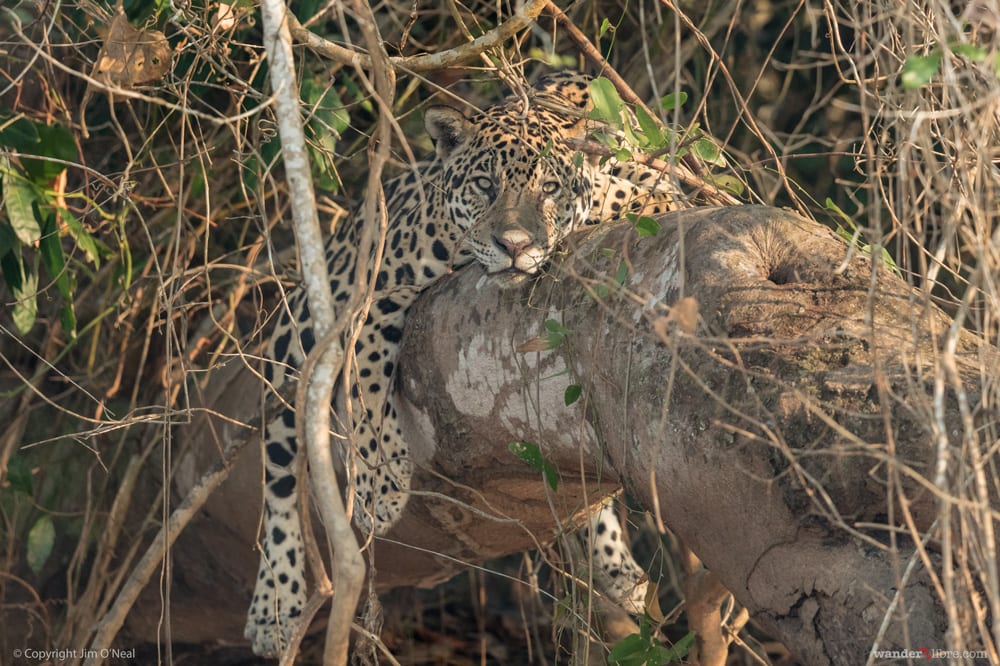
If that’s all we saw in the Pantanal, I would have been more than satisfied. But if jaguars are the marquee attraction, then it’s the incredible biodiversity that gives the Pantanal its true life. Unlike the Amazon, where wildlife can be hard to spot, wildlife in the Pantanal feels omnipresent. In between jaguar sightings, we spotted capybara, caiman, buffalo, tiny proboscis bats, and jabiru storks to name a few. But it was the giant river otters that took center stage. Hunting in lethal packs, we’d frequently see them patrolling the rivers, often following them until they disappeared, only to see them reemerge further down river with fish in hand and blood on their faces – an outward manifestation of their latest killing spree. It’s no wonder they’re often called ‘river wolves.’
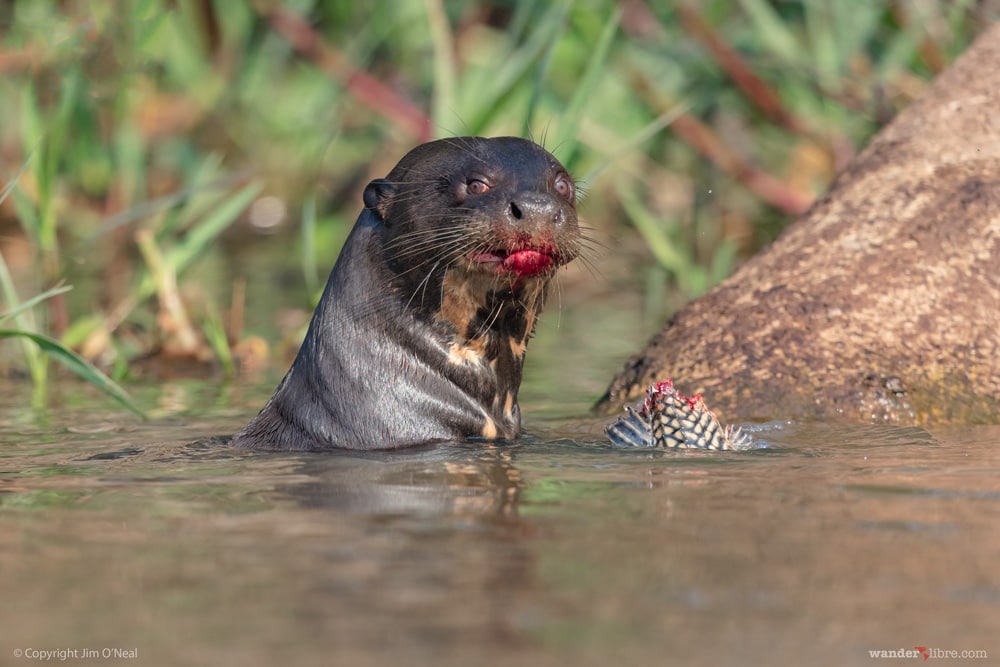
And traveling by road, particularly along the Trans-Pantaneira, was equally rewarding with excellent sightings of giant anteaters, tapirs, fox, capybara, caiman, and birdlife. Birds are particularly plentiful. We witnessed so many kingfishers, cormorants, heron, and egrets snatching fish that photographing it felt a bit like shooting the proverbial fish in a barrel.
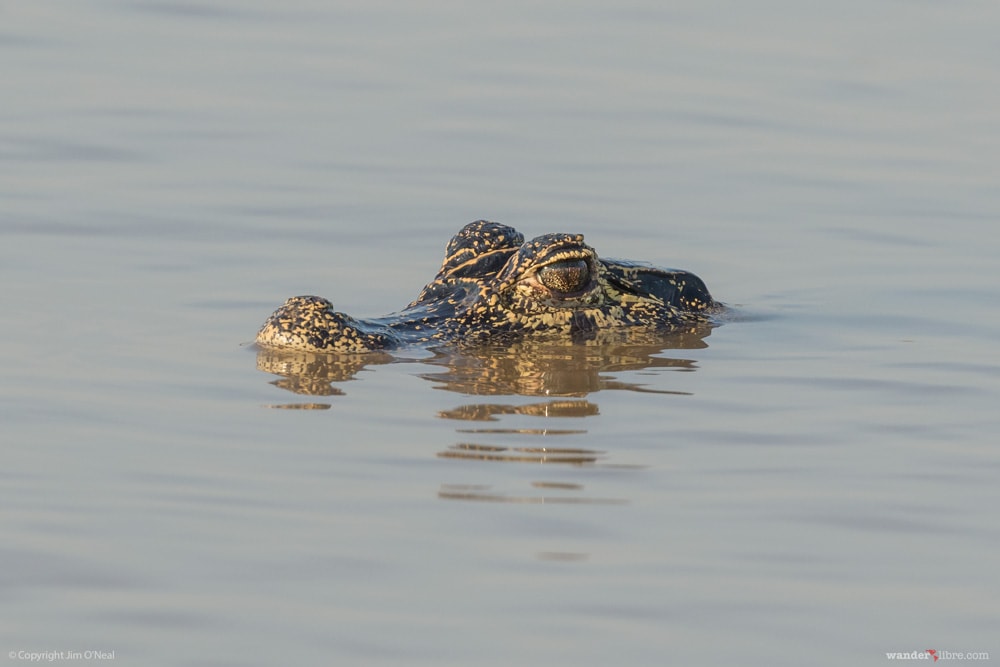
Without question, our time in the Pantanal ranks at the top of our South American wildlife experiences. If you share our passion for wildlife and you’re interested in seeing jaguars and a staggering abundance of birds and other wildlife, then we highly recommend making the trip.
To help you get started, we’ve provided some useful planning tips based on our personal experience. Hopefully, it will help kick-start your planning and allow you to get the most from your trip.
Planning Your Trip to the Pantanal
The Best Time to See Jaguars in the Pantanal
The dry season, which runs from July to October, is the best time to visit the Pantanal to see jaguars. As the season progresses and the floodplains dry up, jaguars move to the rivers, making them easier to spot by boat. To maximize our chances, we went in September. The tail end of the dry season, it was exceedingly hot but, in exchange for the heat, we got excellent sightings.
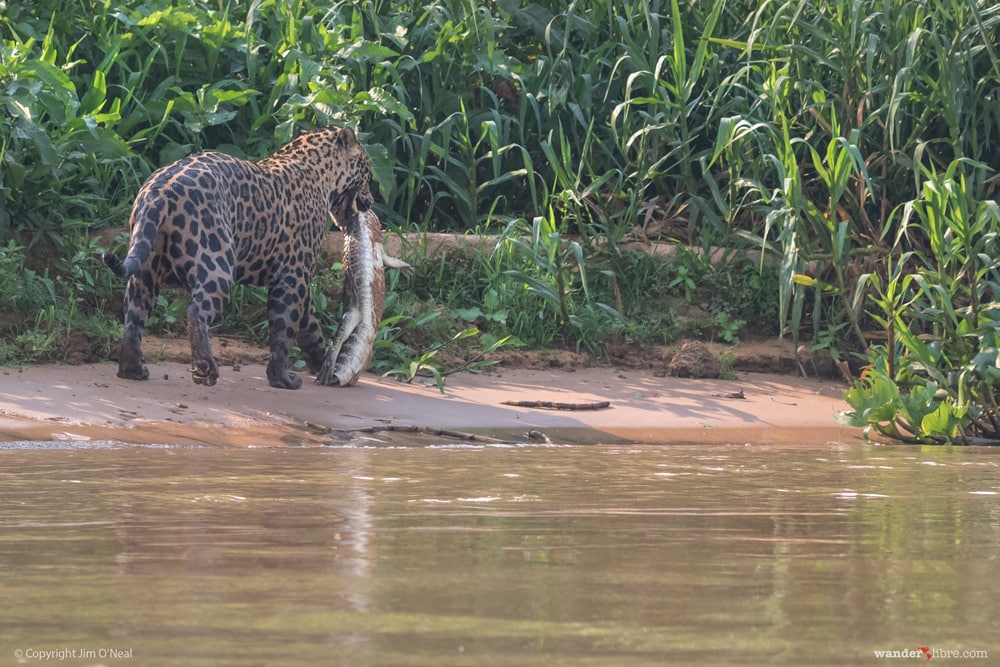
Where to See Jaguars
There are several ways to see jaguars, ranging from DIY independent travel (self-drive, camp, book a la carte boat trips), to all-inclusive photography and wildlife viewing tours with stay aboard houseboats and full-service eco-lodges. We chose the DIY option.
In the dry season, the best place to see jaguars is around Porto Jofre, a convenient base for exploring the Pantanal by boat. We stayed at Pantanal Jaguar Camp, which worked out well as we were allowed to camp and book boat trips a la carte. Jaguar camp offers simple air-conditioned rooms with private bath and wifi, plus a restaurant and bar with delicious buffet meals serving Brazilian / Pantanal cuisine. Jaguar viewing trips are in fast, comfortable 8-seat steel hulled speedboats.
The other option in Porto Jofre is Hotel Pantanal Norte, which offers both fishing and jaguar tours. Larger and more upscale than Jaguar Camp, Hotel Pantanal Norte has additional amenities including an airstrip and pool. At the time of writing, however, they don’t allow camping.
Wherever you choose, try to book as far in advance as possible. Pantanal Jaguar Camp only has six rooms, which Ailton said are booked solid during peak season.
Not interested in the DYI option? Click here to learn more about a multi-day tour to Northern Pantanal, starting in Cuiaba.
How to Get to the Pantanal
The main transportation hub for trips into the northern Pantanal is in Cuiaba, which has all the amenities of a major city and regular air service to Sao Paolo and other cities in Brazil.
Porto Jofre is located 150 miles / 5 ½ hours from Cuiaba. The first 60 miles are along good tar roads and the final 90 are via the graded dirt Transpantaneira road, which crosses over 120 bridges before reaching its terminus in Porto Jofre.
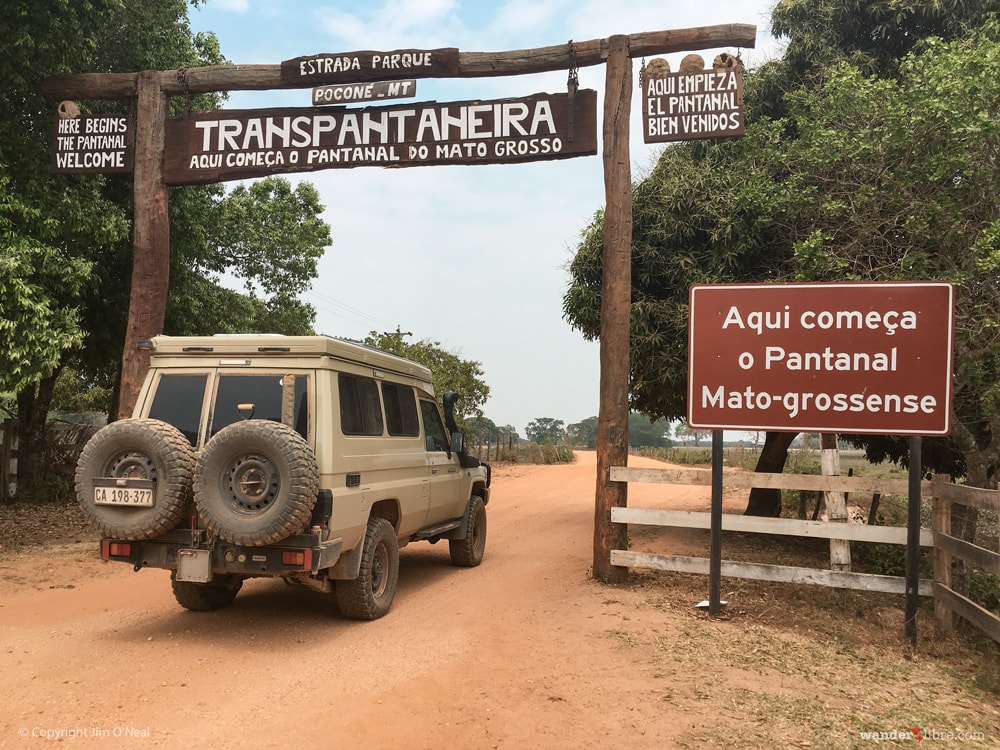
Most of the tourists we met were on tours that included round-trip transfers. Based on our experience in the dry season, it’s also possible to drive yourself. During our visit we found the Transpantaneira to be in pretty good condition and suitable for passenger cars. The bridges, however, were a bit dodgy in places and we were advised to take them slowly to avoid a flat.
Booking a Jaguar Boat Tour
Boat trips to see jaguars are typically booked in advance as part of a lodging package. We were fortunate and, despite being fully booked, Pantanal Jaguar Camp allowed us to camp and book boat trips without reservations. It’s best to check ahead, however, to ensure their policy hasn’t changed before you arrive.
Using our experience at Jaguar Camp as a guide, here’s a brief overview of what a typical trip is like. From Porto Jofre, small motorboats are used to search for jaguars along the riverbanks. Excursions are typically either a half or full day with boats departing around 7:30 a.m. and returning at sunset, with a 2-hour break for lunch in the middle of the day.
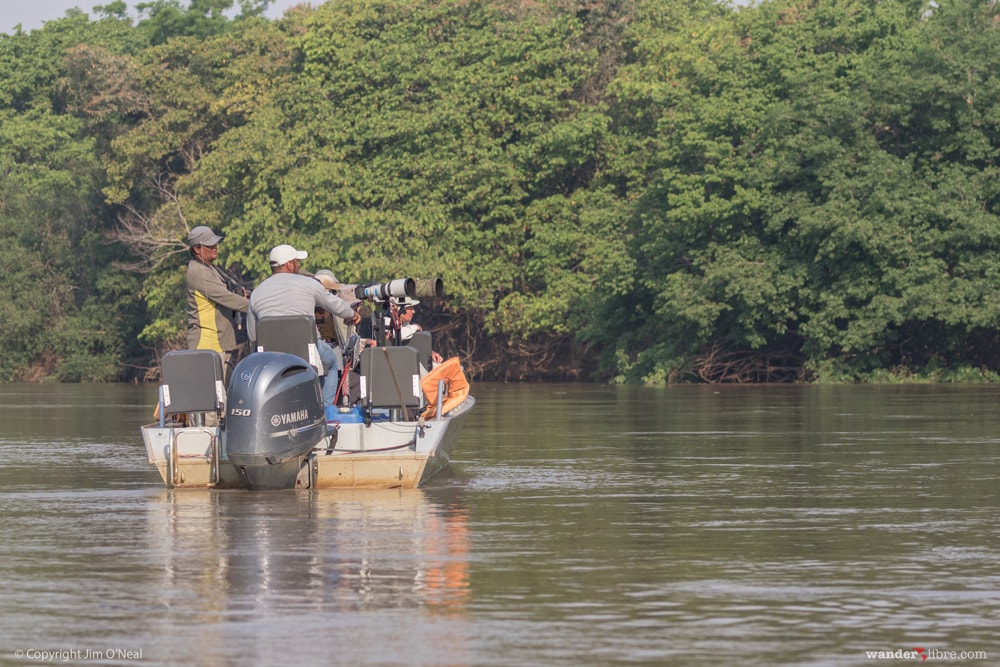
Most tours take place in simple 4-12 passenger speedboats powered by 40-150 hp outboard motors. Our boat had individual padded seats with a cooler full of cold water and beer. In our observation, the boats used by different lodges/tour operators are pretty similar, with some boats offering retractable canopies, fixed tripod mounts for photography (usually provided on specialty photo tours), and larger engines. The size of the motor is perhaps the most important of these differences as the Pantanal is vast and maximizing sightings requires covering as much ground as possible. Imagine getting a radio report from another guide saying they’ve spotted a jaguar hunting only to miss the kill because your 40hp boat couldn’t get there in time. The boats we used at Jaguar camp were basic but fast with comfortable seats but no canopy or tripod mount.
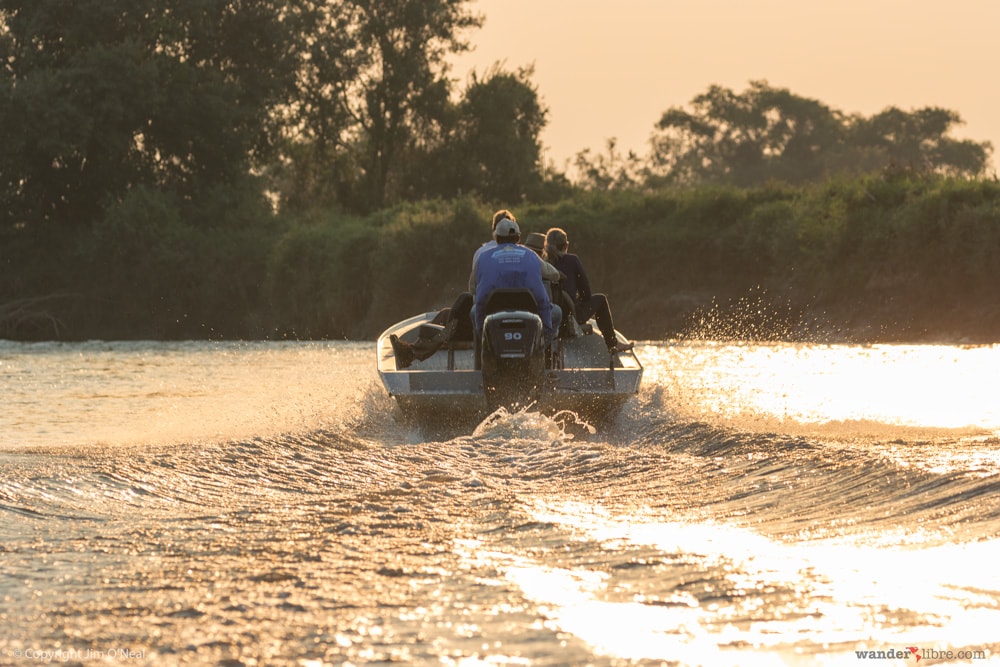
What to Bring
In a nutshell, just remember this about the Pantanal. It’s beautiful, but hot and buggy. As long as you come ready for these two things, you’ll be well prepared. Here’s a quick summary of what to bring on the boat.
Sun Protection
While we saw a couple of boats using canopies/umbrellas, Ailton explained that guides feel it’s poor etiquette to use sun shades as they can obstruct the view of other boats. That said, it’s important to bring plenty of sun protection including sunglasses, hat, long sleeves, pants, and sunscreen.
Bug Protection
Bugs aren’t a problem when the boat is moving, but sit for long and it’s a different story. Wearing long sleeves/pants helps with both sun and bug protection. Just don’t forget the bug repellent. We like to carry wipes since they pack small and we don't have to worry about checking them on a plane or the repellant leaking on our clothes. Repel is a good option if you'd like to use a product with DEET, while Natrapel is a good DEET alternative.
Jacket
As hot as it gets during the dry season, you should still bring a jacket. Racing across the water in a speedboat, particularly around sunset, can get surprisingly cool.
Binoculars
No explanation necessary. Just know you’ll be using them a lot.
Camera Gear (See Photo Tips Below)
Water / Snacks
Chances are your guide will bring a cooler but check just to be sure.
Additional Wildlife Viewing Opportunities / Side Trips
Don’t Miss the Transpantaneira
Porto Jofre is largely about boat trips to see jaguars. If you’re interested in spending some time on land, consider adding a stay at one of the lodges located along the Transpantaneira. The Transpantaneria is rich in wildlife, and there are many lodges along the road that offer jeep tours, walking safaris, birding from observation towers, horseback riding and a variety of other activates.
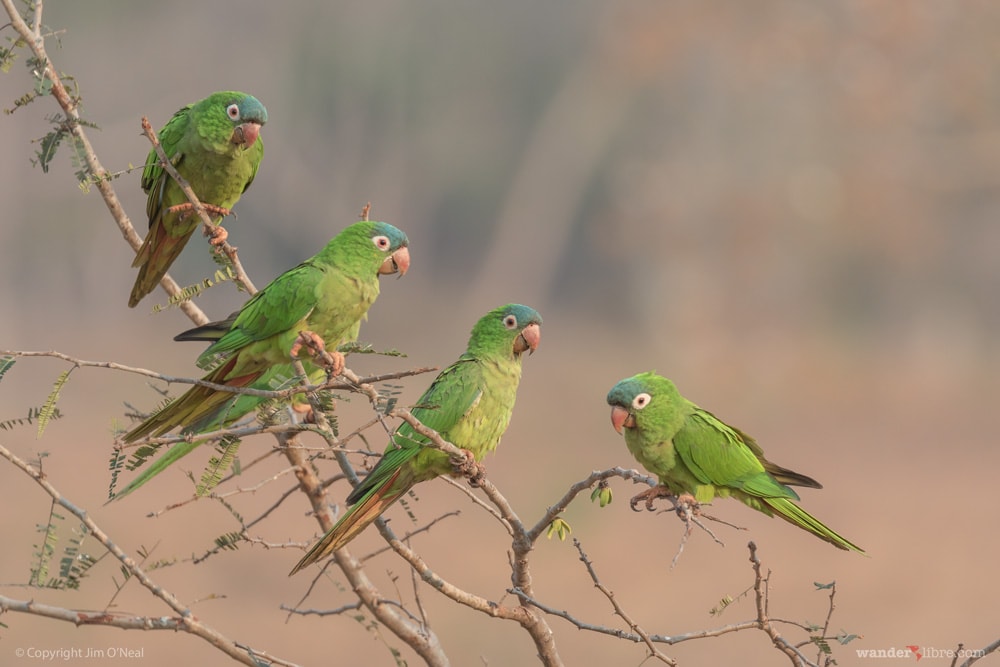
If you’re driving yourself, it’s easy to stop anywhere along the road to view wildlife. We spent several days at Pousada Vitoria, which has a nice pool, several activities, and an observation tower that’s nice for bird watching. Unfortunately, the staff only speaks Portuguese and German.
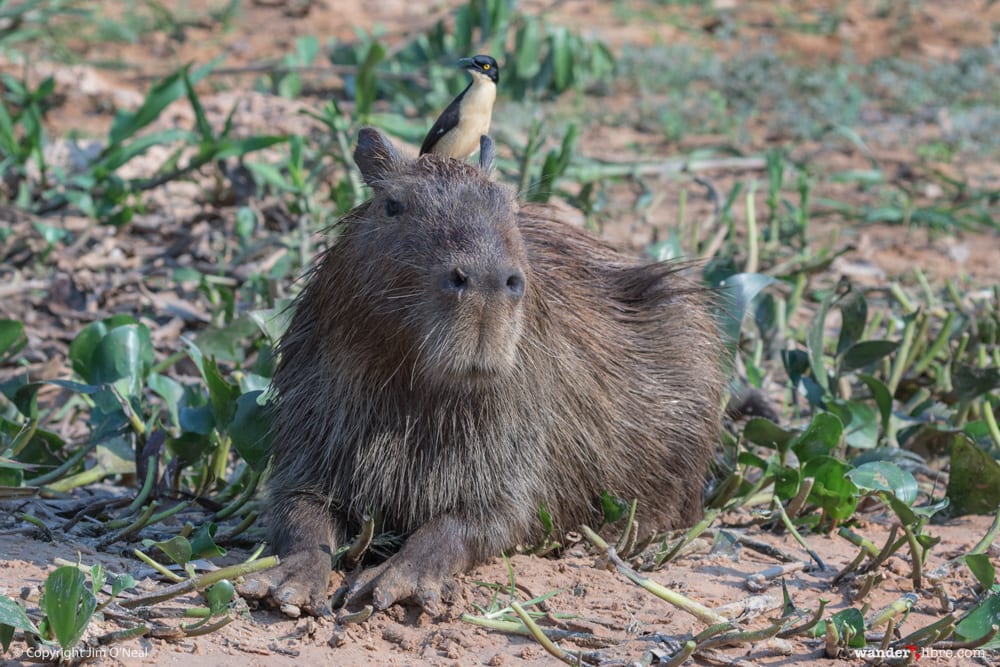
Add Bonito, Brazil for Colorful Macaws
While it’s possible to see Macaws in the Pantanal, nothing compares to Buraco Das Araras. Located near Bonito on the southern side of the Pantanal, Buraco Das Araras is to macaws what Porto Jofre is to jaguars. Imagine a 330' deep sinkhole surrounded by forest. Fill it with armadillos, coatis, anteaters, foxes, caiman, and some 130 bird species. Add 100 colorful macaws soaring across the chasm - their calls reverberating off the hole's limestone walls - and you get Buraco Das Araras. Visiting Buraco Das Araras is a visceral experience. Loud and colorful, it's a great to place to view and photograph macaws and an excellent spot to become immersed in the call of the wild. We visited in the breeding season (Sep), which pairs perfectly with seeing jaguars.
Want more? Bonito’s other draw is snorkeling with hundreds of fish in the crystal clear rivers that run through the area. Book a floating trip through this beautiful aquatic playground.
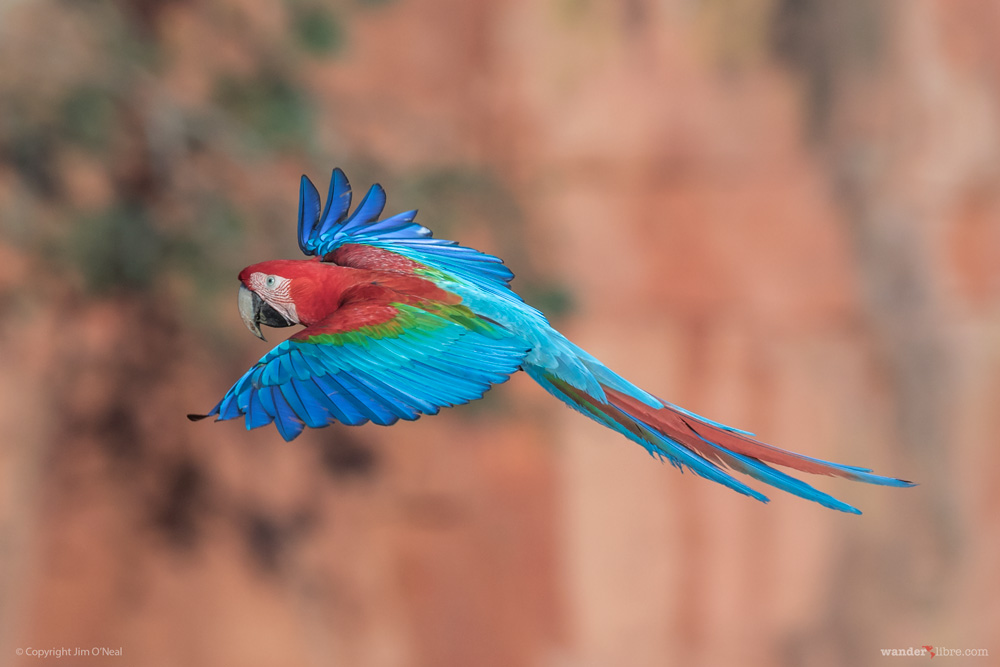
Drive the Estrada Parque (Southern Pantanal)
One of the highlights of our trip to the Pantanal was seeing giant anteaters. I’m not sure what I expected to see, but I can tell you what we saw was something completely different. Giant anteaters are amazing. Massive. Furry. Odd. They’re a marvel of nature like nothing else. Typically accessed from either Corumba or Campo Grande, the Estrada Parque - a dirt road running through the southern Pantanal - is an excellent spot for wildlife viewing and good place to see giant anteaters.
Take the MS-419 Short Cut Between Porto Jofre & Bonito if you’re driving yourself and your itinerary includes Porto Jofre and Bonito, consider taking the MS-419. The 419 serves as a scenic shortcut on the long drive between Bonito and Porto Jofre, which also has a reputation as a good spot for it seeing giant anteaters. We took this road in September and saw a taper, fox, and giant anteater with her baby.
If you would prefer booking a tour to see the southern section of the Pantanal, click here to learn more about a multi-day tour that combines the southern Pantanal with beautiful Bonito.
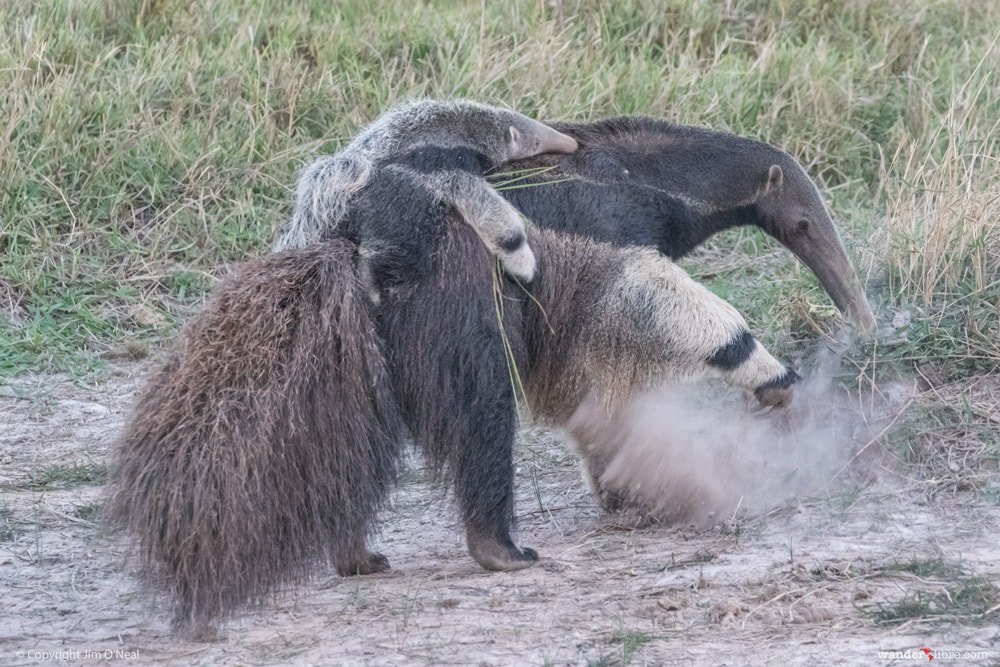
Keep Your Eyes Open in Camp
Don’t forget to keep a lookout in camp. Between our stays at Pantanal Jaguar Camp and Pousada Vitoria, we saw capuchin monkeys, tapir, parakeets, macaws, feral pig, giant rococo toad, and a tarantula just to name a few.
Photographing Jaguars in Brazil - What to Expect on Your Trip
If you’re serious about photography and you’re wondering what gear to bring, here’s a brief overview of the general shooting environment. The details provided below are based on our experience. Hopefully, it will help guide your decisions on what cameras and other photo gear to bring.
Environment
Traveling by boat down the Pantanal’s network of rivers, our jaguar sightings took place either in the water (jaguars swimming), on sandy beaches, under shady trees, or in dense riverside vegetation. This can present some truly unique photo opportunities (i.e., jaguar swimming or drinking water along a white sand beach). It can also present a challenge, as unsightly vines and other distractions surrounded some of the jaguars, which I found hard to eliminate from photos.
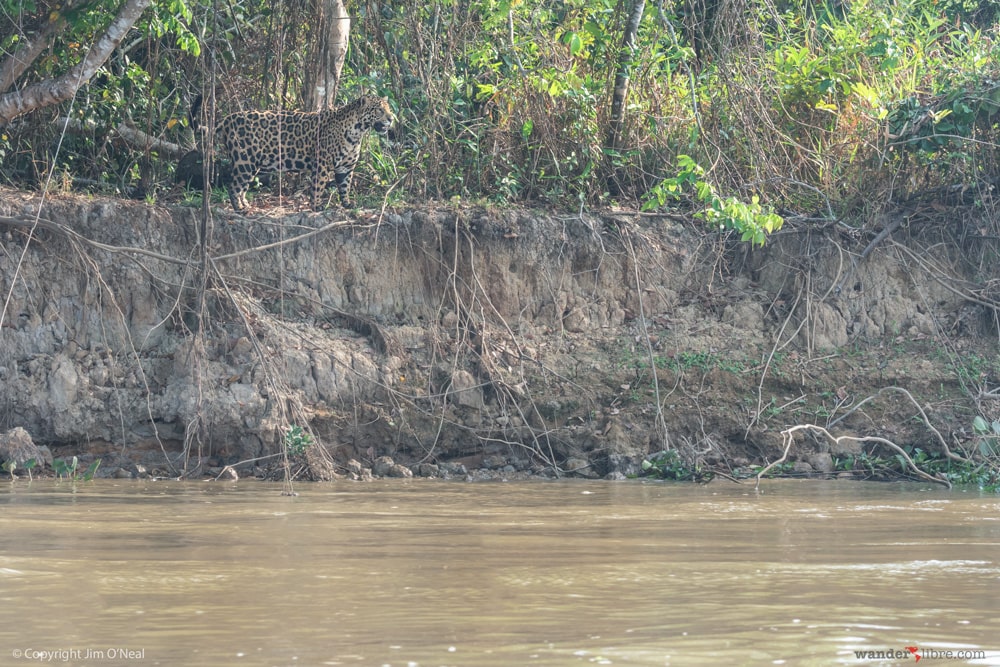
Time of Day
With Pantanal Jaguar Camp’s boats departing around 7:30 a.m. and returning at sunset, the majority of our jaguar sightings took place between mid-morning and mid-afternoon.
Lighting
While I’d hoped for soft early morning and later afternoon lighting conditions, the majority of our jaguar sightings took place in a combination of bright light (i.e., jaguar swimming) and dark shadows (i.e., jaguar lazing under a shady tree).
Subject Distance
While some rivers are fairly wide, most of our sightings were along somewhat narrow rivers where it was possible to get reasonably close to the jaguars. Consequently, I rarely found myself longing for lots of extra focal length (see gear used below).
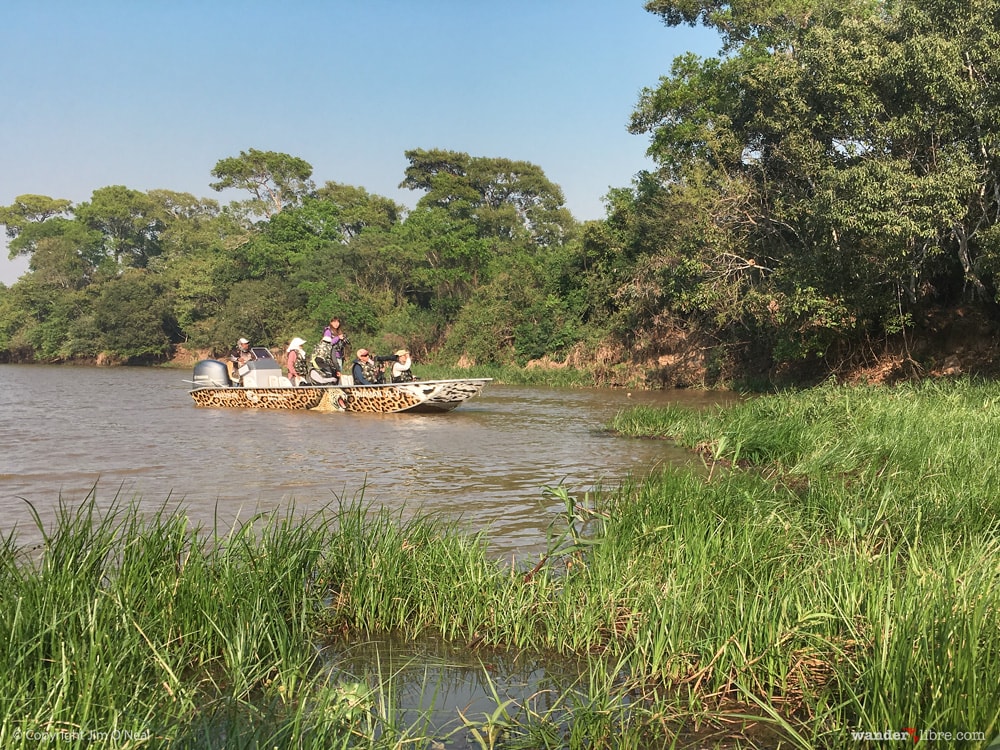
Shooting Scenario
You’ll be shooting from a small boat that’s often moving, either to follow the action or from a wake caused by another boat. Generally, our sightings included jaguars that were either resting in the shade of riverside trees or actively hunting (either swimming, moving along a sanding beach, or in and out of dense vegetation).
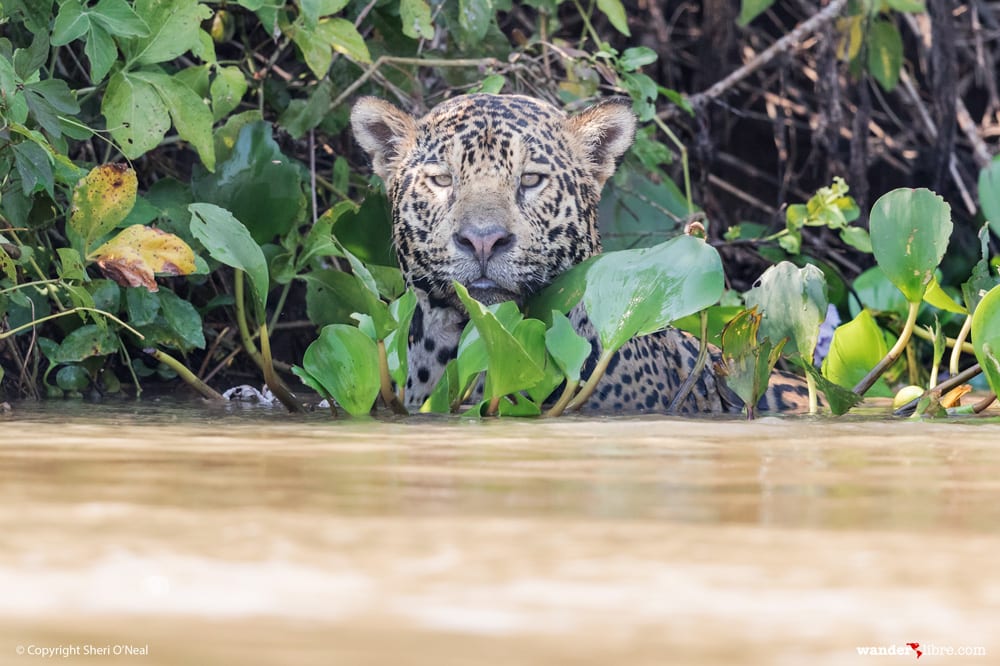
If you’re on a dedicated photography tour, it’s possible your boat will have permanent tripod mounts, which is nice. Like many operators, at Pantanal Jaguar Camp there were no tripod mounts. If you’re planning to bring a tripod/gimbal setup, try to sit in the front row so that you’ll have an optimal field of view and room to setup/maneuver a tripod with a long lens.
We carried two cameras as well as a tripod w/ gimbal. On the tripod, I mounted a 500mm f4 (IS) with full frame body. Handheld I used a 100-400mm 4.5-5.6 L (IS) with an APS-C body. Under ideal conditions where the boat wasn’t moving and I was in the front row, I found the 500mm setup worked well. Many times, however, the boat was moving so I found it easier to handhold the smaller lens, which was easier to track and steady.
Shutter Speed
It goes without saying but shooting a moving subject from an unstable platform is a recipe for unsharp images. I tried to keep my shutter speed as high as possible, and in the bright sunlight, was generally able to achieve acceptable speed without problems.
We witnessed several sighting where jaguars were hunting, so be ready and set your shutter speed accordingly to make sure you don’t miss/blur the moment.
Hopefully that covers the basics. If you have specific questions, feel free to reach out to us. We’re happy to help any way we can.
Related Posts:
10 Unique Experiences in South America
Like this Post? Pin It!
We are a participant in the Amazon Services LLC Associates Program, an affiliate advertising program designed to provide a means for us to earn fees by linking to Amazon.com and affiliated sites.

I’m a wildlife and bird photographer, specialize in animal behavior, wildlife tour guide, and active in wildlife conservation in Israel.
I want to get to the Pantanal to photograph jaguars, for about nine to ten days. during June, July or early September this year. (At the best time in terms of the activity of the jaguars)
My plan is to come alone or with one partner, so that I can get the best results.
I would be very happy if you could help me with planning and organizing all in order to achieve the best results.
I speak Spanish and English.
Best regards,
My cell phone/WhatsApp +972544635100
Hi Yorum. Thanks for your message. You will find that the Pantanal is a great place to photograph jaguars. Unfortunately, we don’t assist with organizing tours. I would suggest you get in touch with Ailton Lara at Pantanal Jaguar Camp (https://www.pantanaljaguarcamp.com.br) and he should be able to assist you or point you in the right direction. Good luck with your planning!
I understand the requirement to shoot at fast shutter speeds. What ISO were you typically using? I have a full frame Sony A7 III with a 70-300 mm lens that I plan on using. Did you shoot any video?
Hi Wayne. The ISO varied a lot depending on if I was shooting with my 500mm f4 vs. my 100-400mm f4.5-5.6 (which at 400mm has a max aperture of 5.6). Generally, it ranged between 400 and 1250 when shooting at F/4 with 400 being very sunny shots of jaguars swimming in the river and 1200 being shadier shots along the river banks. I have some shots that go up the ISO 3200 and beyond (shooting into shady forest). The max aperture on your 70-300 and weather / light will have a major impact on the ISO you’ll need to use to get shutter speeds of 2000. From what I’ve heard, the A7 III’s high ISO performance is good so you should have some latitude.
Also, we shot some video, however it wasn’t our primary focus. We shot environmental video with our iPhone and wildlife mainly with our 7D Mk II.